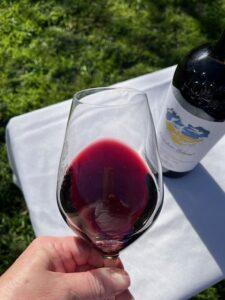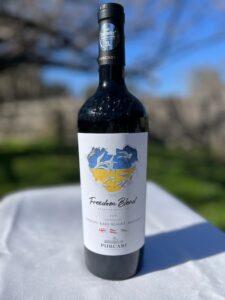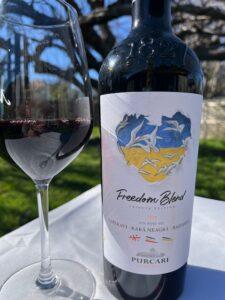Chateau Purcari — Freedom Blend Tribute Edition
“The heart of Georgia, the terroir of Moldova, the free spirit of the Ukraine.”
65% Saperavi, 20% Rara Neagra, 15% Bastardo
Indigenous grape varieties from each nation:

Saperavi— Georgia— late ripening, high yield, high altitude, hardy grape
Bastardo (cross of Trousseau & Saperavi)- -Ukraine
Rara Neagra— Moldova
Aged for 12 months in French oak barrique
Color– ruby
Viscosity– high
Nose– leather, ripe red berries,
Acid– low medium
Body– medium
Tannin– soft, medium
Flavors of overripe strawberries, blackberries, vanilla
The History
At the end of the 12th century, the region surrounding the Moldovan village of Purcari and the Agon Zograf monastery vineyards were already recognized as favorable land for viniculture. This land, being in the heart of the special terroir, made Moldova’s wine industry a major sector of Southern Europe’s economy. French settlers recognized similarities with Bordeaux in France in climate and soil. They then partnered with the monastery and began producing special vintages from Purcari in the 18th century.
In 1827, Emperor of Russia Nicholas I issued a special decree that gave Purcari special status as the first specialized winery in Bessarabia. It took two decades for Purcari to win its first gold medal in the competition. The Paris World Expo saw Negru de Purcari win its first gold medal in the International Exhibition, surprising French wine experts with a dry wine with an intense ruby color that was NOT from Bordeaux.
For a long time after this, Purcari wines were as popular as wines from Burgundy or Bordeaux, being served to European Royalty such as Emperor Nicholas II, King George V, and Queen Victoria of Great Britain.
In 1950 (after World War II), Purcari entered a new era with the Moldovan winemakers restoring classic production techniques. Wineries were rebuilt, new wineries were established, and Purcari wines again rose to popularity.
At the turn of the 21st century, Chateau Purcari replanted 250 hectares (617 acres) of vineyards and installed state-of-the-art technology. It also entered 25 new markets across the world, including the U.S., Canada, the U.K., and China, as well as many others. Since 2010, the company has launched several new vintages that have received awards and acclaim, including the special award of the Grand Prix of winemaking by the Republic of Moldova government for its outstanding achievements in winemaking and promoting Moldova’s image abroad.
The Grapes

The vineyards that were planted in 2003 reached maturity in 2023, and the quality of those grapes was significantly better than before. Highlighting the fact that today, the winery is more advanced and complex than it ever has been in its almost two centuries of existence and is poised to continue the trend moving forward.
The Purcari vineyard is located In Moldova (just 1under 10 miles from the border with Ukraine), and Freedom Blend came into being in 2014 after the annexation of Crimea, based on a 2011 vintage. The 2011 vintage was designed to celebrate 20 years of freedom from the Soviet Union. (In 1991, Moldova became an independent republic.) The blend is intended to be a tribute to the courage and resistance of these three countries, an act of gratitude for the heroic fight and resistance of the Ukrainian people—a symbol of solidarity within an area that has been facing military aggressions from neighboring nations for generations.
Saperavi
Saperavi is a highly successful grape from Georgia, which has flourished in Moldova since the late 19th century (when it was still part of the Russian Empire). It arrived in Moldova at about the same time as Cabernet Sauvignon, which is the most commonly planted grape in this country. It grows in loose clusters that are fairly disease-resistant. Due to its marked acidity, it has been used in cheaper blended wines. However, in recent decades, it has proven to be able to produce age-worthy (often barrel-matured), high-quality wines.
Rara Neagra
Rara Neagra (the name translates to “rare black”) is not widely planted- it is a late-ripening grape from Moldova. In other countries where it’s grown, it goes by versions of this name, depending on the primary language. It is believed that this varietal is the result of selective breeding in the 14th century. It grows in medium bunches, with the grapes being flattened or occasionally spherical in shape, covered in a bluish, waxy patina. While it is sensitive to frosts, it is seldom affected by insects or fungi. It is used for both wines and juices. It was first officially recognized in 1946 in the Register of Plant Varieties of Moldova.
Bastardo
Bastardo is a grape from France, but when crossed with Saperavi, it becomes Bastardo Margarachsky. The cross (used in this wine) was made in 1949 in Crimea (Ukraine), gaining protection in 1969. It is resistant to drought and is used mainly for blending. However, in 2016, there were only 180 hectares of vineyards of this grape in Moldova.
The Wine
 This is a bold but easy-to-drink red blend. The deep ruby (almost purple) color sets the stage for the aromas of ripe berries and leather. On first taste, the ripe red and black fruit is held up with notes of vanilla. The tannins are strong but soft, taking a few more tastes before the drying effect is fully felt. As it warms past the cool serving point- the berry profile becomes richer, like eating fresh, ripe fruit off the vine on a summer day.
This is a bold but easy-to-drink red blend. The deep ruby (almost purple) color sets the stage for the aromas of ripe berries and leather. On first taste, the ripe red and black fruit is held up with notes of vanilla. The tannins are strong but soft, taking a few more tastes before the drying effect is fully felt. As it warms past the cool serving point- the berry profile becomes richer, like eating fresh, ripe fruit off the vine on a summer day.
While Chateau Pucari is in Moldova with Ukraine to its east (current fighting is on the far east border of Ukraine and Russia)- in 2022, it was reported that the winery was helping refugees fleeing the war in Ukraine. The wine industry in Moldova/Ukraine is suffering for a multitude of reasons. Everything from acquiring bottles and labels to exporting their wine has been thrown into turmoil. Costs are being driven up, while tourism to the wineries has dwindled, and some of the local markets (like Ukraine) have all but stopped purchasing. The wine industry (as well as their economy in general) in Ukraine has come to a near full stop. The destruction of buildings, machinery, and vineyards has thrown the future of the wine industry into the air.
Politics aside, I am a person who enjoys wine and respects the work that goes into each bottle. I strongly suggest seeking out wines from these countries; keep your local wine shop stocking the wines they can get so that in a couple of years when the rebuilding starts- there is demand for the wines from our side of the world.



Comments are closed.